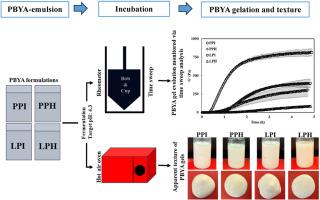由脉冲蛋白分离物及其水解物制备的搅拌酸奶替代品的凝胶动力学和流变性能
IF 11
1区 农林科学
Q1 CHEMISTRY, APPLIED
引用次数: 0
摘要
本研究研究了脉冲蛋白的酶解对植物基酸奶替代品(PBYA)的凝胶动力学、流变学和摩擦学特性的影响。豌豆(PPI)和扁豆(LPI)分离蛋白被部分水解至约1%的水解度。两种分离蛋白(PPI和LPI)及其水解产物(PPH和LPH)通过发酵制备PBYA。发酵诱导的凝胶化过程耗时近5 h,达到pH 4.3为目标pH。与PPI-和LPI-PBYA相比,PPH-和LPH-PBYA凝胶的凝胶硬度降低。疏水相互作用在稳定PBYA凝胶结构方面占主导地位,与水解处理无关。相反,部分水解增加了PPH-和LPH-PBYA中的其他分子间相互作用,例如静电、氢键和二硫相互作用。尽管有这样的增加,但搅拌后的PPH-和LPH-PBYA的凝胶粒径减小,协同作用速率增加。这些现象可能是由于在水解过程中产生了较小尺寸的多肽。因此,蛋白质-蛋白质相互作用的反应性组分的总体数量可能会增加;这导致蛋白质聚集体或网络结构更紧密,但不一定加强凝胶结构,这是由疏水相互作用介导的。由水解产物(PPH或LPH)制成的PBYA在老挝政权中测试的流变性能表现出更高的频率依赖性。这些发现可以指导新产品开发活动,以改善PBYA纹理的光滑和柔软的纹理属性。建议今后的研究努力探索提高PBYA凝胶相稳定性的方法。本文章由计算机程序翻译,如有差异,请以英文原文为准。

Gelation dynamics and rheological properties of stirred yogurt alternatives manufactured from pulse protein isolates and their hydrolysates
This study investigated the impact of enzymatic proteolysis of pulse proteins on the gelation dynamics, rheological, and tribology properties of plant-based yogurt alternatives (PBYA). Pea (PPI) and lentil (LPI) protein isolates were partially hydrolyzed to ∼1 % degree of hydrolysis. Both protein isolates (PPI and LPI) and their respective hydrolysates (PPH and LPH) were used to manufacture PBYA via fermentation. The fermentation-induced gelation took nearly 5 h to reach pH 4.3 as the target pH. The gel hardness of PPH- and LPH-PBYA gels was reduced compared to PPI- and LPI-PBYA. Hydrophobic interactions dominated in stabilizing the PBYA gel structure, irrespective of the hydrolysis treatment. In contrast, partial hydrolysis increased other intermolecular interactions in PPH- and LPH-PBYA, e.g., electrostatic, hydrogen bonding, and disulfide interactions. Despite such an increase, stirred PPH- and LPH-PBYA exhibited reduced gel particle size and increased syneresis rate. These phenomena may be attributed to the production of smaller-sized polypeptides during hydrolysis. Consequently, an increase in the overall population of reactive components for protein-protein interactions may be expected; this resulted in a more compacted structure of protein aggregates or network, but not necessarily strengthening the gel structure, which is mediated by hydrophobic interactions. PBYA made from hydrolysates (PPH or LPH) showed higher frequency dependence regarding rheological properties tested in LAOS regimes. These findings may direct new product development activities for improving PBYA texture with smoother and softer textural attributes. Future research efforts are recommended to explore approaches for improving PBYA gel phase stability.
求助全文
通过发布文献求助,成功后即可免费获取论文全文。
去求助
来源期刊

Food Hydrocolloids
工程技术-食品科技
CiteScore
19.90
自引率
14.00%
发文量
871
审稿时长
37 days
期刊介绍:
Food Hydrocolloids publishes original and innovative research focused on the characterization, functional properties, and applications of hydrocolloid materials used in food products. These hydrocolloids, defined as polysaccharides and proteins of commercial importance, are added to control aspects such as texture, stability, rheology, and sensory properties. The research's primary emphasis should be on the hydrocolloids themselves, with thorough descriptions of their source, nature, and physicochemical characteristics. Manuscripts are expected to clearly outline specific aims and objectives, include a fundamental discussion of research findings at the molecular level, and address the significance of the results. Studies on hydrocolloids in complex formulations should concentrate on their overall properties and mechanisms of action, while simple formulation development studies may not be considered for publication.
The main areas of interest are:
-Chemical and physicochemical characterisation
Thermal properties including glass transitions and conformational changes-
Rheological properties including viscosity, viscoelastic properties and gelation behaviour-
The influence on organoleptic properties-
Interfacial properties including stabilisation of dispersions, emulsions and foams-
Film forming properties with application to edible films and active packaging-
Encapsulation and controlled release of active compounds-
The influence on health including their role as dietary fibre-
Manipulation of hydrocolloid structure and functionality through chemical, biochemical and physical processes-
New hydrocolloids and hydrocolloid sources of commercial potential.
The Journal also publishes Review articles that provide an overview of the latest developments in topics of specific interest to researchers in this field of activity.
 求助内容:
求助内容: 应助结果提醒方式:
应助结果提醒方式:


